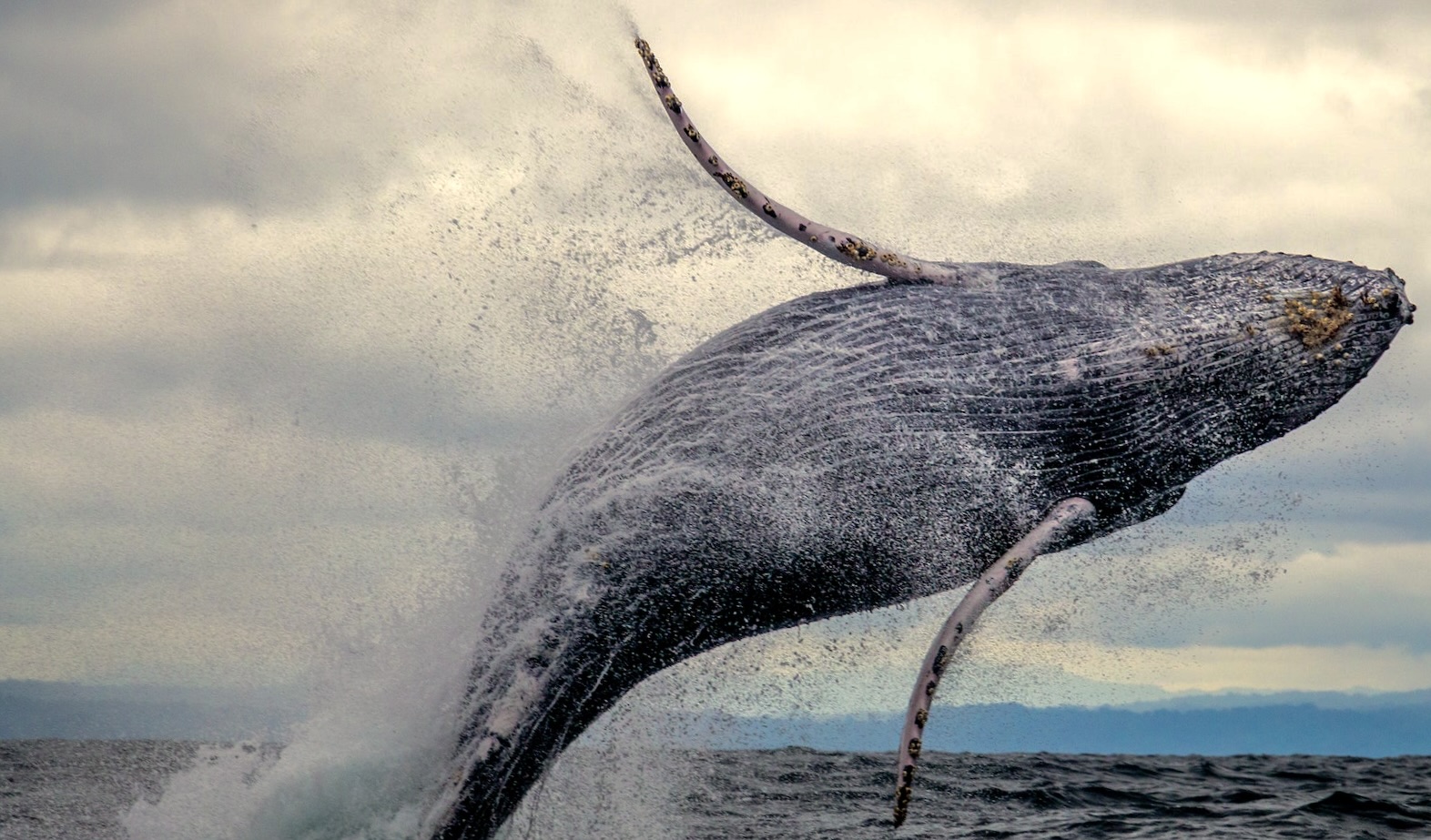
In January 2023, Surfrider published a statement on the large number of whale deaths on the East Coast. We decided to update that blog, as the deaths have continued and more information has been made public. Sadly, there is still no clear answer for why these deaths are occurring.
Since 2016 and continuing today, the National Oceanic and Atmospheric Administration (NOAA) has been studying a humpback whale “unusual mortality event” (UME) on the East Coast. Similar UMEs occurred in the 2000s, for example, 48 humpback whale mortalities were documented in 2006. NOAA performed necropsies on some of the current UME whales and the top two causes of death were determined to be ship strikes and fishing gear entanglements.
Since early December 2022, at least 16 whales, mostly humpback but at least two toothed whales and four North Atlantic right whales, have washed up on the East Coast (half of those in New York and New Jersey). Marine mammal stranding groups are currently performing necropsies on some of the whales (as others were too decomposed to analyze).
Baleen whales (like humpbacks) do not use sonar and hear at different frequencies than toothed whales, and are therefore less sensitive to noise. For this reason, they have not historically been connected with beachings from loud offshore noises like oil and gas exploration or Navy testing.
It is still unclear exactly what data collection and mapping activities the offshore wind industry has been implementing off the East Coast since 2016 in total, but they have not yet begun turbine installation, the loudest part of wind farm deployment. Additionally, the type of sound imaging used by the offshore wind industry is very different from the type used by the oil and gas industry and the Navy. This lower energy type of sonar is frequently used by ocean research vessels and is not linked with whale beachings.
Offshore wind industry boats are required to have marine mammal spotters on board. These spotters can stop wind industry activity if whales get too close, and are legally required to report any whale collisions to NOAA. It is possible that an offshore wind boat struck one of the beached whales, but there are hundreds of large boats offshore, so the chance that these deaths were caused by wind boats specifically, is low.
On January 19, 2023, NOAA held a press conference stating that, not only is there no evidence connecting the offshore wind industry to recent whale deaths, but also that, “There is no information that would support any of the equipment being used [by the wind industry] could directly lead to the death of a whale.”
On February 21, 2023, the Marine Mammal Commission, an independent oversight body of marine mammal experts, released a statement saying that, “Despite several reports in the media, there is no evidence to link these strandings to offshore wind energy development.”
So why are there so many whale deaths recently? Theories have ranged from a change in the abundance and location of their food sources, to humpback whale population increases, to unknown climate change impacts, to increases in shipping container vessel traffic entering and exiting the NY/NJ Harbor. Besides the known cases of entanglement with fishing gear and ship strikes, scientists continue to research this question.
Surfrider is very concerned about the scientifically predicted climate change scenarios that will result in major negative impacts to our coasts and ocean. We know that we must move from fossil fuels to renewable energy as fast as possible to avoid these negative impacts.
At the same time, we are concerned about the many possible negative impacts from the development of offshore wind energy projects. Accordingly, Surfrider has adopted a Policy on Offshore Renewable Energy that includes principles for responsible development. This policy guides Surfrider’s evaluation of offshore wind projects, and has led us to request additional scientific study, monitoring, and mitigation for any offshore wind project.
Furthermore, we are assessing each offshore wind project separately, and have been waiting for the Construction and Operations (COP) step in the federal government’s approval process before we take a position on a particular project. At the COP step, we can access the environmental analysis prepared pursuant to the National Environmental Protection Act, which lays out the possible impacts from each project. Our chapters are then able to decide whether or not to support specific offshore wind projects.
Surfrider has a 20 year history of protecting the East Coast, including defeating proposed projects for liquefied natural gas, poorly planned development, and offshore oil drilling. As recently as 2020, the federal government was contemplating oil leases on the East Coast. As our country looks for more energy sources to feed increasing energy demands, especially for electricity, Surfrider will continue to monitor proposed energy projects, including offshore wind, to ensure the protection of our coasts and ocean for all people.
For more information, this story in NJ Spotlight includes a lot of great information, as does this Rutgers Q&A.
REFERENCES
(1) NOAA Fisheries. 2016–2023 Humpback Whale Unusual Mortality Event Along the Atlantic Coast.
Available at: www.fisheries.noaa.gov/national/marine-life-distress/2016-2023-humpback-whale-unusual-mortality-event-along-atlantic-coast
(2) NOAA Fisheries. Active and Closed Unusual Mortality Events. Available at: www.fisheries.noaa.gov/national/marine-life-distress/active-and-closed-unusual-mortality-events
(3) NOAA Fisheries. Frequent Questions—Offshore Wind and Whales. Available at: www.fisheries.noaa.gov/new-england-mid-atlantic/marine-life-distress/frequent-questions-offshore-wind-and-whales?fbclid=IwAR2TXmI7xEfF89Cws7dmZJWYxkgnqTfl-nd6Fj3ql0D15bGharPlYOa_Z5c
(4) NOAA Office of Protected Resources. 2018 Revision to Technical Guidance for Assessing the Effects of Anthropogenic Sound on Marine Mammal Hearing (Version 2.0). Available at: media.fisheries.noaa.gov/dam-migration/tech_memo_acoustic_guidance_(20)_(pdf)_508.pdf
(5) Ibid.
(6) Long Island Press. Feds: Offshore Wind Not to Blame for East Coast Whale Deaths
Available at: www.longislandpress.com/2023/01/19/feds-offshore-wind-whale-deaths/
(7) USDOT. Maritime Trade and Transportation by the Numbers. Available at: www.bts.gov/archive/publications/by_the_numbers/maritime_trade_and_transportation/index
(8) The Press of Atlantic City. NOAA: Wind Power Could Not Have Caused Whale Deaths. Available at: pressofatlanticcity.com/news/local/noaa-wind-power-work-could-not-have-caused-whale-deaths/article_ed70011c-977b-11ed-b492-cf78ee93ccfa.html
(9) Marine Mammal Commission. Update on Strandings of Large Whales Along the East Coast. February 2023. Available at: www.mmc.gov/wp-content/uploads/Update-on-Strandings-of-Large-Whales-along-the-East-Coast-2.21.2023.pdf
(10) NJ Spotlight. The East Coast Whale Die-Offs: Unraveling the Causes. March 15, 2023. Available at: www.njspotlightnews.org/2023/03/scientists-say-no-evidence-that-offshore-wind-development-has-contributed-to-whales-strandings-and-deaths/
